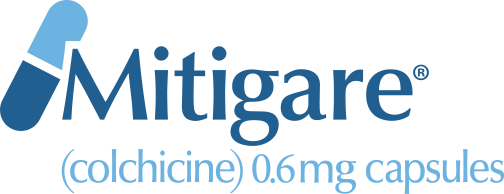
Gout is a type of inflammatory arthritis caused by a build-up of uric acid crystals in the bloodstream.1 This condition causes crystals to form and build up around one or more joints.1 People with gout suffer from episodes of pain, redness, swelling and/or extreme tenderness in a joint, often the big toe.1 The disease affects more than 8 million people in the US.2 Read on to find out more about the most common risk factors for gout.
Non-modifiable risk factors for gout
A number of risk factors contribute to your risk of gout. Some are non-modifiable, which means they can’t be changed. Non-modifiable risk factors for gout include:
Gender
In the US, gout affects three times as many men as women.2
Age
Men tend to develop gout in their fifties.3 Women tend to develop gout in their sixties.3
Family history
Gout tends to run in families.1 If your parents or siblings have (or had) gout, you are more likely to have it.1
Certain medications
Although you may need them to maintain your health, certain medicines can increase your risk of gout.4 These medicines include4:
- Diuretics (often taken to reduce high blood pressure and ease edema)
- Salicylate-containing drugs (such as aspirin)
- Niacin (also known as Vitamin B3 or nicotinic acid)
- Cyclosporine (used to suppress the immune system following an organ transplant)
- Levodopa (used to treat Parkinson’s disease)
Never stop or start a medication without first talking with your doctor.
Medical conditions
Certain medical conditions, such as untreated blood pressure, diabetes, metabolic syndrome and heart and kidney diseases can increase your risk of gout.1
Recent surgery or trauma
Your risk of gout increases if you’ve recently had surgery or suffered trauma.1
Modifiable risk factors for gout
Fortunately, a few risk factors for gout are modifiable, which means you have some control over them. These include:
Your diet
Consuming foods and drinks that are high in purines, such as meat, certain types of seafood, sweets, juices and alcoholic beverages can increase your risk of developing gout.1 Fasting or following diets designed for rapid weight loss can also raise your risk.1
Your weight
Being overweight causes the body to produce excess uric acid.1 This may lead to higher levels of uric acid in the bloodstream and an increase in gout risk.1
Preventing gout flares
If you have gout and you’ve suffered with flares, don’t get discouraged. There are many things you can do to help prevent gout flares.
Drink more water
Research has shown that drinking more water can reduce your risk of gout flares.1
Follow a gout-friendly diet
Choose moderate portions of healthy food options that are lower in purines, such as fruits, vegetables and whole grains.5 Good protein sources include lean meat and poultry, low-fat dairy products and certain legumes, such as lentils.5
Lose weight if needed
If you are overweight, losing extra pounds can help reduce your body’s burden of uric acid.1 Talk with your doctor about sensible ways to reduce your weight if necessary, and how you can increase your level of fitness with exercise.
Try medication
Medications to prevent gout flares are available. is one of the most frequently used medicines for preventing gout flares.6 Learn more about prescription colchicine here.
Don’t give up
Changing your habits may be difficult at first, but even small adjustments may help.7 Be sure to talk with your doctor about gout flare prevention and how you can live better with gout.
NOTE: This article was not written by a medical professional and is not intended to substitute for the guidance of a physician. These are not West-Ward’s recommendations for gout flare prevention, but rather facts and data collected from various reliable medical sources. For a full list of resources and their attributing links, see below.
